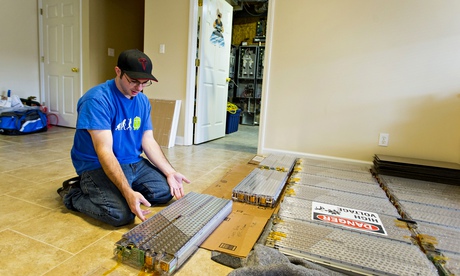
In a small garage in suburban New Jersey, a man has hacked an electric car battery. And used it not, as you might imagine, to solve the energy crisis or time-travel a DeLorean back to 1955 … but to power his own home. Employing nothing more than a battery the size of a single mattress, some unfathomable technological wizardry, a year of his time and $20,000, Jason Hughes has managed to store energy from his solar-power system, meaning he can blow-dry his hair, charge his mobile phone, and stick the kettle on after Better Call Saul, all thanks to an out of whack Tesla Model S.
It may sound like a more extreme way to go off-grid than putting your name down for an allotment but batteries are having their moment in the sun. (Not the actual sun; that would make them explode.) Tech giants, startups and hackers are all doing their bit to jumpstart the humble battery’s fortunes and transform the way we use and store energy at a global level.
The electric car company Tesla, with investment from Panasonic, is behind the world’s first Gigafactory, a $5bn powerhouse in the Nevada desert set to open in 2020 and dedicated to doubling the world’s production of lithium-ion batteries. These are the batteries that power mobile phones and electric cars and haven’t evolved much since their invention in 1991 by Sony. The aim is to mass produce them just as Henry Ford did with automobiles, halving battery prices by 2020. Just think. “Range anxiety” (the fear electric car drivers experience, knowing they will soon need to recharge), the rage that comes with needing to charge your mobile phone more regularly than you feed yourself and the confusion over whether we should keep laptops plugged in during use or not – all this could be relegated to the past.
So how easy is it to hack a car battery? Not very. A slew of boring time-lapse YouTube videos in which you can watch a man take a battery apart – slowly, meticulously, and incomprehensibly – reveal you would have more luck trying to fashion a flux capacitor out of a pair of tights. On the website hackaday.com, a Tesla battery hacker, when asked about the difficulties of tearing down the pack, replied that “a wrong move … could mean instant death”. Best not try.
Chances are we won’t need to anyway. Earlier this year Tesla’s chief executive Elon Musk confirmed the company was also working on a battery pack for the home which should go into production within the next six months. Capable of storing energy from solar or wind, the battery could be the missing link between renewable energy and your average homeowner who is never going to end up on Grand Designs but wouldn’t mind going a bit more off-grid. Though prices aren’t yet known, many believe the new technology will save on utility bills. And until the future arrives, we’ll always have the Tesla Model S.

